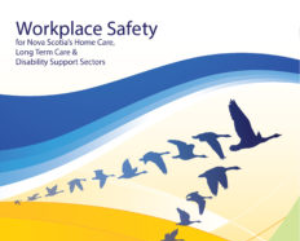WORKPLACE SAFETY ACTION PLAN
Workplace Safety Action Plan
for Nova Scotia’s Health Care and Community Services Sectors
Our province’s health and community services sectors play a critical role in the health and well-being of Nova Scotians, and combined are the largest employer group in the province. However, these sectors have been under pressure to meet steadily increasing demands.
But did you know that workers in these sectors are more likely to be injured on the job than any other type of worker? Accounting for 20 per cent of total assessable payroll, the health and community service sectors account for almost 30 per cent of time-loss claims to WCB Nova Scotia. That means three out of ten time-loss claims originate in these sectors. The cost to Nova Scotia is much more than the time-loss claim, backfill and disability support; every injured worker is a service provider unable to support a patient or client who needs them. And every injured worker suffers their own upheaval from being hurt and off of the job.
Over a two year period, the Workplace Safety Action Plan was developed under a multi-stakeholder project of AWARE –NS, the Departments of Health and Wellness, Labour and Advanced Education, and Community Services, the Nova Scotia Health Authority, IWK Health Centre, and WCB Nova Scotia , organized labor and employers to develop a five-year Workplace Safety Action Plan for Nova Scotia’s Health and Community Services Sectors focused on improving occupational health and safety outcomes specifically for home care, long-term care, and community services sectors. Knowing that these work environments are very complex, its work included:
- An environmental scan to identify best practices for improving health and safety in the health and community services sectors that could be included the Action Plan.
- An assessment of the current state of workplace health and safety for these sectors in Nova Scotia, including current health and safety performance in health and community services, possible causes of work-related injuries, challenges or barriers that contribute to work-related injuries, and current or planned assets and activities that contribute to improving health and safety outcomes in these sectors. This work involved a review of related documents and data, and interviews with key informants working in these sectors from across the province. Evidence-based Best Practices & Assessment of Current State in Nova Scotia
- Consultations with stakeholders from the health and community services sectors in development of the plan through the creation and implementation of a communication and engagement strategy. Consultation Findings
- Working Group series– over 90 individuals across stakeholder groups (employers, workers, government, organized labour, etc.) were engaged in a working group process to identify potential actions for inclusion in the Action Plan. (Link to Brief)
A report has been finalized that sets out 21 recommendations to improve safety outcomes in home care, long term care, and disability support program sectors; Charting the Course: Workplace Safety for Nova Scotia’s Home Care, Long term Care & Disability Support Sectors
Evidence-based Best Practices & Assessment of Current State in Nova Scotia
Consultation Findings
Reports by the Nova Scotia Health Research Foundation
Action Plan Partners
- AWARE-NS
- Government of Nova Scotia
- Nova Scotia Health
- IWK Health Centre
- WCB Nova Scotia
- Organized Labour (NSGEU, NSNU, CUPE, Unifor)
Sector Partners, Associations and Councils
- WCB NS – health & social services Nova Scotia | health care injuries (worksafeforlife.ca)
- Dept Labor and Advanced Education : Health and Safety | novascotia.ca
- Dept Health and Wellness continuing Care – Continuing Care | novascotia.ca
- Department of Community Services/Disability Support Program – Disability Support Program | Nova Scotia Department of Community Services
- NS Health Continuing Care – Nova Scotia Health Authority (nshealth.ca)
- IWK Health – IWK Health Centre – IWK Health (nshealth.ca)
- Nursing Homes of Nova Scotia Association (nhnsa.ca)
- Health Association NS/Member Forums – www.healthassociation.ns.ca
- Diverse Abilities NS – About | Diverse Abilities NS
- Continuing Care Association of Nova Scotia – Continuing Care Association of Nova Scotia (continuingcareassociationns.com)
- NS Residential Agencies Association – Home Page – Nova Scotia Residential Agencies Association (nsraa.ca)
- Healthcare Human resources Sector Council – HCHRSC (hcsc.ca)
- NSGEU
- NSNU
- CUPE
- UNIFOR



